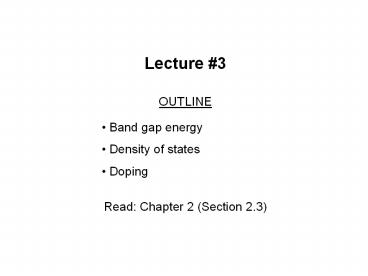OUTLINE - PowerPoint PPT Presentation
1 / 13
Title:
OUTLINE
Description:
Lecture #3 OUTLINE Band gap energy Density of states Doping Read: Chapter 2 (Section 2.3) Band Gap and Material Classification Measuring Band Gap Energy Density of ... – PowerPoint PPT presentation
Number of Views:69
Avg rating:3.0/5.0
Title: OUTLINE
1
Lecture 3
- OUTLINE
- Band gap energy
- Density of states
- Doping
- Read Chapter 2 (Section 2.3)
2
Band Gap and Material Classification
E
c
E
9 eV
G
E
c
E
1.12 eV
G
E
E
E
v
v
c
metal
SiO2
Si
- Filled bands and empty bands do not allow current
flow - Insulators have large EG
- Semiconductors have small EG
- Metals have no band gap
- conduction band is partially filled
3
Measuring Band Gap Energy
EG
can be determined from the minimum energy (hn)
of photons
that are absorbed by the semiconductor.
Band gap energies of selected
semiconductors
4
Density of States
E
gc(E)
DE
E
E
c
c
E
E
v
v
gv(E)
g(E)dE number of states per cm3 in the energy
range between E and EdE Near the band edges
E ? Ec
E ? Ev
5
Doping
By substituting a Si atom with a special impurity
atom (Column V or Column III element), a
conduction electron or hole is created.
6
Doping Silicon with Donors
Example Add arsenic (As) atom to the Si crystal
The loosely bound 5th valence electron of the As
atom breaks free and becomes a mobile electron
for current conduction.
7
Doping Silicon with Acceptors
Example Add boron (B) atom to the Si crystal
The B atom accepts an electron from a neighboring
Si atom, resulting in a missing bonding electron,
or hole. The hole is free to roam around the
Si lattice, carrying current as a positive charge.
8
Donor / Acceptor Levels (Band Model)
E
c
ED
Donor Level
Donor ionization energy
Acceptor ionization energy
Acceptor Level
E
A
E
v
Ionization energy of selected donors and
acceptors in silicon
9
Charge-Carrier Concentrations
ND ionized donor concentration (cm-3) NA
ionized acceptor concentration (cm-3) Charge
neutrality condition ND p NA n At thermal
equilibrium, np ni2 (Law of Mass Action)
Note Carrier concentrations depend on net dopant
concentration (ND - NA) !
10
N-type Material
ND gtgt NA (ND NA gtgt ni)
11
P-type Material
NA gtgt ND (NA ND gtgt ni)
12
Terminology
donor impurity atom that increases n acceptor
impurity atom that increases p n-type material
contains more electrons than holes p-type
material contains more holes than
electrons majority carrier the most abundant
carrier minority carrier the least abundant
carrier intrinsic semiconductor n p
ni extrinsic semiconductor doped semiconductor
13
Summary
- The band gap energy is the energy required to
free an electron from a covalent bond. - EG for Si at 300K 1.12eV
- Insulators have large EG semiconductors have
small EG - Dopants in Si
- Reside on lattice sites (substituting for Si)
- Group-V elements contribute conduction electrons,
and are called donors - Group-III elements contribute holes, and are
called acceptors - Very low ionization energies (lt50 meV)
- ? ionized at room temperature
Dopant concentrations typically range from 1014
cm-3 to 1020 cm-3

























![[READ]⚡PDF✔ Black Letter Outline on Contracts (Black Letter Outlines) 5th Edition PowerPoint PPT Presentation](https://s3.amazonaws.com/images.powershow.com/10044064.th0.jpg?_=20240531080)


![[PDF] DOWNLOAD FREE Clinical Outline of Oral Pathology: Diagnosis and PowerPoint PPT Presentation](https://s3.amazonaws.com/images.powershow.com/10076578.th0.jpg?_=20240711025)


